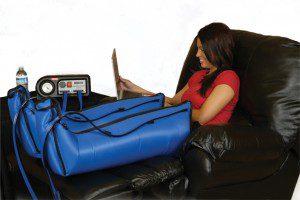By Alyssa Parker –
 Many individuals attempt to manage their limb swelling through various treatments such as compression stockings, exercise, diuretics, and elevation with little or no results. Limb swelling, also known as edema, may be a symptom of an underlying medical condition. Some of the most common conditions where limb swelling is the first symptom include venous insufficiency, post operative trauma, infection, and lymphedema. Clinicians may overlook the cause of your swelling; Lymphedema or venous insufficiency is not always evident in their earliest stages. It’s important to seek treatment early on to prevent further complications. These conditions can be easily misdiagnosed as acute and minor swelling followed with minimal treatment. Pneumatic compression devices are one of the most highly recommended treatments for these conditions and are recognized by Medicare.
Many individuals attempt to manage their limb swelling through various treatments such as compression stockings, exercise, diuretics, and elevation with little or no results. Limb swelling, also known as edema, may be a symptom of an underlying medical condition. Some of the most common conditions where limb swelling is the first symptom include venous insufficiency, post operative trauma, infection, and lymphedema. Clinicians may overlook the cause of your swelling; Lymphedema or venous insufficiency is not always evident in their earliest stages. It’s important to seek treatment early on to prevent further complications. These conditions can be easily misdiagnosed as acute and minor swelling followed with minimal treatment. Pneumatic compression devices are one of the most highly recommended treatments for these conditions and are recognized by Medicare.
Lymphedema and Chronic Venous Insufficiency
After having a surgical procedure cancer or non-cancer related (example hysterectomy or gallbladder removal) it may take months or years for Lymphedema to manifest because of its slow progression. It is imperative that Lymphedema is treated quick and effectively, regardless of the severity. Complications dramatically decrease when treatment is started in the earliest stage of Lymphedema. When left untreated common complications include cellulitus or lymphangitis, skin changes such as skin thickening, restricted movement of a limb, or chronic wounds. Aside from surgical procedures and radiotherapy for cancer other known triggers include vein stripping, peripheral vascular surgery, trauma, inflammation, infection, and insect bites.
Chronic venous insufficiency is another condition that causes swelling in the legs along with open wounds. CVI occurs when the valves in the veins that normally channel the blood to the heart become damaged which then leads to pooling of the blood in the lower extremities. Discoloration of the skin, referred to as hemosiderin staining, is identified by a reddish staining of the lower limb. From poor circulation shallow wounds may develop due to the stagnant blood that would normally return to the heart. Symptoms vary but may include swelling, aching, itching or burning, varicose veins, infection, chronic venous ulcer, and decreased mobility.
Treatment
A widely recognized and highly effective treatment is using a compression pump. This is a safe and effective way to assist your body’s circulatory system in moving the excess fluid which has accumulated in the limb and can cause painful swelling, non-healing wounds, heaviness, and discomfort decreasing your mobility. The compression pump is a gentle massaging technique that compresses in a rythmatic cycle, similar to that of a normally functioning lymphatic system that has not been damaged. This is a great treatment option for patients who have tried compression stocking, elevation, diuretics, or massage with little or no relief. This is a safe and effective way to assist your body’s circulatory system in moving the excess fluid which has accumulated in the limb and can cause painful swelling, non-healing wounds, heaviness, and discomfort decreasing your mobility.
This is where choosing a physician experienced in recognizing and treating Lymphedema or CVI is critical. Some good questions to ask your physician include:
. Does my family have a history of swelling (Hereditary Lymphedema)?
. Stemmer’s sign present?
. Pitting (push your finger into your skin and count how long it takes to return) or skin hardening?
. Hemosiderin staining (port wine skin stains or “red socks”) appear from the ankles down
. Traumatic injury or surgery potentially damaging Lymph nodes (Hip replacements, etc)?
. Radiation to Lymph areas?
Remember ANY swelling is an indication of an overloaded Lymphatic system.
The compression pump is recognized by Medicare and covered by many commercial insurers; Actual coverage varies with individual plans.Acute Wound Care, LLC is a highly focused local provider of wound products and compression pumps working with select area physicians highly versed in this condition.
For more information and articles on this topic, Google “Acute Wound Care” or visit www.AcuteWoundCare.com or call 239-949-4412 and speak with a specialist.







